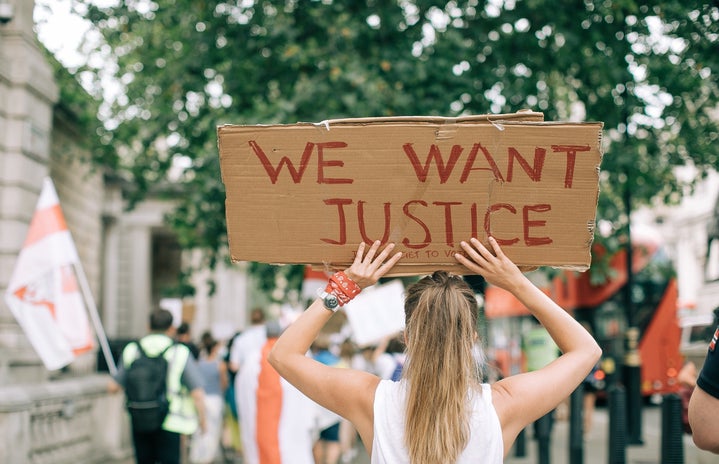Disclaimer: This article is not meant to invalidate or lessen the severity of the crimes of anyone. Every crime victim deserves equal and adequate media coverage and investigation. This article discusses the topics of race, murder, kidnapping, crimes, and mistreatment of people of color.
Gaby Petito, Caylee Anthony, Madeline McCann, and Jon Bonnet Ramsey. You probably know these names, especially if you are an avid lover of true crime. But have you heard of Alexis Patterson? Or Relisha Rudd? If not, it’s not your fault. As a culture, we are obsessed and fascinated with crimes committed against white women, which is why serial killers Ted Bundy and Charles Manson are so famous. But this problem also stems from the implicit racism in how our society handles crimes committed against people of color. We see this through a lack of media coverage or police involvement in active investigations. Understanding this issue is crucial to not only help solve decades-long murder mysteries but to further educate ourselves on what implicit racism looks like.
In recent years, we have been more exposed to crimes against POC than ever before. The world witnessed the murders of George Floyd, Elijah McClain, Breonna Taylor, and most recently, Tyre Nicholas. The deaths of these beautiful lives are not as uncommon as it seems:1 out of every 5 African Americans dies earlier than the average white person. Not only that, but black Americans make up 13% of the population but makeup 31% of missing person cases, and 34% of women and girls missing are black. These alarming rates seem to be across the board, especially among indigenous women.
The nonprofit Native Hope shares the murder rate among women living in reservations is ten times higher than the national average and is the third leading cause of death for indigenous women. Native Women Wilderness also states that four out of five indigenous women experience violence in their lifetime and are three times more likely to be murdered than white women. Even though there were 5,712 reports of missing American Indian and Alaska Native women, the U.S. justice department only logged 116 cases. So why do we barely know about these statistics? Well, let’s look at the sources we all rely on to get our information, the internet.
So you’d think all people would be treated equally in the media after their death, right? Well, not really. A nonprofit journal, The Marshall Project, wrote an article describing how black Americans are portrayed in the media. Black victims received an average of 2.8 news articles each while white victims received 3.8 news articles. In those articles, when discussing a murder of a black person, authors stated facts such as time, place, and names while white victims received more tribute from their friends and family. These problems of the media became strikingly obvious during the investigation of Gabby Petito in 2022. Gabby disappeared in Wyoming, a state which houses many Native American reservations and also has had 400 cases of missing women from 2011-2020. But the week Petito went missing, her case was covered in the news 346 times. Unfortunately, that’s not uncommon for white women who go missing, it’s known as Missing White Women Syndrome.
Missing White Women Syndrome is a term that came from Gwen Ifill, a PBS news anchor, who created the term to discuss how mainstream media is fascinated with covering the cases of white missing women but not women of color. Now, this term is not to say white women who go missing or are murdered shouldn’t receive media coverage, but it should be equal to their non-caucasian counterparts. This syndrome was especially relevant in the year 2002 when two girls both disappeared a month apart but one got significantly more coverage than the other. The Milwaukee Journal writes about how Elizabeth Smart was 14 years old in Salt Lake City when she was kidnapped in the middle of the night and found nine months later. A month before she was kidnapped, Alexis Patterson, a seven-year-old African American girl went missing in broad daylight. The day after Elizabeth disappeared, the FBI was called in and helped gather money for a reward, but didn’t join in for Alexis till three days later. Alexis Patterson is still missing, twenty years later.
Reading about serial killers and indulging in true crime documentaries is fun and fascinating for many, including myself. But as we get wrapped up in these cases, views forget about the injustice in the way that victims are talked about and we don’t see the whole picture.
As a consumer of media, especially if it is related to true crime, it is important to remember a couple of things.
1. Try to remember the victim’s name rather than the perpetrator’s. The victim deserves more coverage than the killer.
2. Research crimes committed against POC, sex workers, homeless people, and other marginalized groups. Familiarize yourself with how police treat these investigations versus white victims.
3. Spread awareness about missing indigenous women and the unlawful deaths of black Americans.
As a society, we need to be better about treating all crimes equally regardless of race, nationality, sexuality, and occupation. We need to be better and we can be better.
Resources:
Donate to the Marshall Project, a nonprofit crime journal
Donate to Native Hope, a nonprofit that spreads awarness about missing indigenous women.
If you know anything about Alexis Patterson and her disappearance, please call the tip line at 414-224-TIPS



